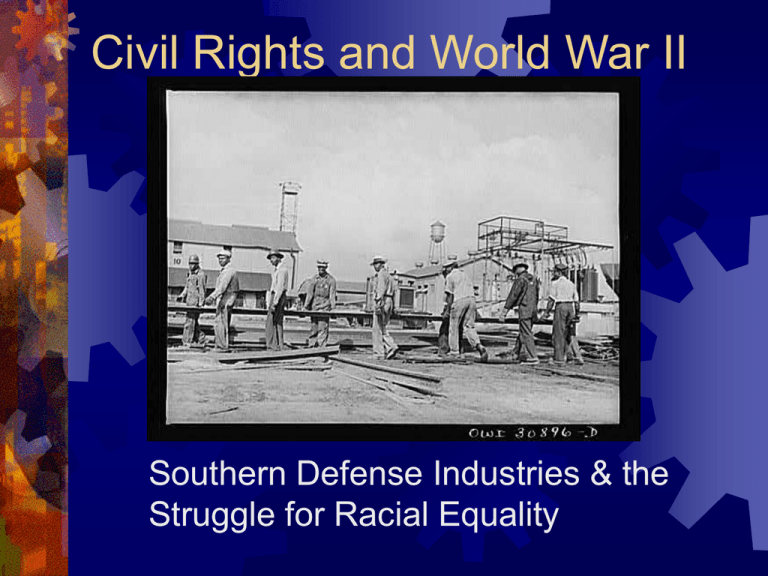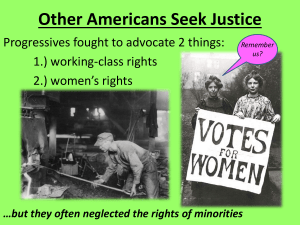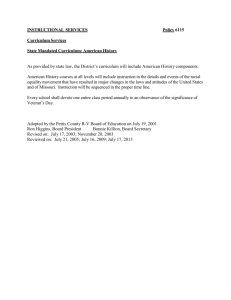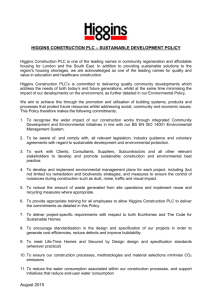Civil Rights and World War II
advertisement

Civil Rights and World War II Southern Defense Industries & the Struggle for Racial Equality World War II and Civil Rights Fight Against Fascism = fight for democracy…for all people U.S. has to set an example at home -gives civil rights advocates leverage Double V = Victory at Home and Abroad Jobs movement calls for equality in the workplace Desegregating the labor market Equal access to training and skilled jobs Equal wages for equal work Victory at Home? Industrializing the South & maintaining Jim Crow Def. Industries come South Segregated Labor Market Skilled and “Unskilled” The Jobs Movement June 1941 – March on Washington Labor, NAACP, NUL unite Threaten to march 100,000s on Washington DC Force FDR’s hand on international stage Executive Order 8802 (6/25/41) creates Fair Employment Practices Committee (FEPC) Voluntary enforcement of equal rights in defense industries EO 9346 (1943): creates new FEPC 1943-1945 field offices file 1000s of cases across the U.S. Training African Americans Manpower Shortage YouTube - Manpower - World War Two (1943) How did New Orleans and Southern Industries respond to this crisis? How do employers maintain Jim Crow and meet the manpower challege? New Orleans Defense Industries Higgins (Uptown, City Park, Ind. Canal) Delta Ship Yards (Liberty Ships on the Industrial Canal) Consolidated Vultee (PBYs at Lakefront) Todd-Johnson Ship Yard (Algiers) Avondale Marine Way (Avondale) Lane Ships (Industrial Canal) Higgins Industries Higgins often promoted as a model of race relations for defense industries. In fact – he hired African Americans in skilled carpentry only – no welders. African Americans at Higgins Eureka Magazine features stories Waiting at the Station, 3/42 The 1942 Liberty Ship Contract Spring 1942 AJH gets $30 million U.S. Maritime Commission contract for Liberty ships - the largest ship contract in USMC history 40,000 - 100,000 workers to move to NO (!?!) AJH pledges to train black and white workers on equal basis – avoid unnecessary inmigration of white workers Praised by Eleanor Roosevelt (the kiss of death within conservative circles) Andrew Jackson Higgins “Our company may be the means of showing that the races can get along well together with equal respect for the other and equal rates for the same work.” Louisiana Weekly, April 1942 “In a nutshell, we are going to use plain common sense, and there is going to be no prejudice.” to FEPC Spring 1942 Liberty Ship Contract Cancelled – October 1942 USMC blames steel shortage Higgins and Congressman Hebert blame oldline East Coast ship builders Black media blames local conservatives – (NOAC, YMBC, AFL Metal Trades) AJH to Fortune magazine, 10/42: “[local opponents] were afraid they might lose their chauffer or have to pay their servants more.” Higgins Features Diverse Workforce Workers in Eureka magazine Diverse Workforce with Asian Welders Integrated Meetings in Eureka Labor Agreement with AFL Limits of Integration Lunch Time Higgins’ Civil Rights Record 1943-5 numerous FEPC cases filed against unequal work conditions, violence and intimidation WMC reports indicate that many black workers quit rather than protest inequality Failed to use trained black welders – after announcing in the Louisiana Weekly (spring 1942) that they would do so Only carpentry open to skilled black workers AFL very conservative – white entitlement Other New Orleans Industries Delta Ship Yards (Liberty Ships on the Industrial Canal) 1/45 upgrades black welders quietly Symbolic victory for skilled black workers Consolidated Vultee (PBYs at Lakefront) 6/43 CVAC hires African American women after lengthy negotiations with NOUL and federal officials) NOUL is a model negotiator for region New Orleans industries resist Avondale No Lane No Todd Marine Way (Avondale) symbolic victory Ships (Industrial Canal) symbolic victory Johnson Shipyards 7/45 Todd-Johnson upgrade of black welder causes all-white walk-out. Other Southern Def Industries in Atlanta – hired skilled African Americans to work in segregated building North American Aviation in Dallas – also hired skilled African Americans Consolidate Vultee in Ft. Worth – minor gains Aviation industry is more open Bell Aircraft Other Southern Industries – AFL dominated, and therefore little gains for Af Ams Shipbuilding – did hire African American women on seasonal basis Ordinance Out migration War Manpower Commission recruits skilled black workers for western and northern industries West Coast pay = $1.50/hr Southern pay = .75/hr Hanford and Oak Ridge, Kaiser, Boeing are considered “top priority” Southern employers resist Personal Stories Arthur Chapman -advances at Pearl Harbor ship yard Personal Stories David Cooper -Ford engine plants – -NO and Detroit -bought his house uptown Af-Am Jobs Gains nationally 1940-1944 African American men employed April 1940: 2.9 million April 1944: 3.2 million African American women employed April 1940: 1.5 million April 1944: 2.1 million Total: 900,000 jobs gained (and eventually lost) Loss of political leverage Victory at Home? Organized labor remains status quo on race and equality in the South – 1940s-50s Most black workers prioritize economic gains Out migration continues after WWII – west coast WWII failed to produce permanent jobs in NO – labor market returns to surplus Delta, Convair, Higgins all close -loss of over 50,000 jobs in New Orleans Cold War eventually helps create jobs at Michoud and Avondale Victory at Home? African American political networks gain confidence and expand across region Labor, Churches, NAACP - Voter Registration Drives in late 1940s ILA 1490 largest black union in the South PDL – A.L. Davis, Ernest Wright The Legacy of World War II jobs movement Civil Rights Act – est. EEOC, which makes equal employment rights a federal law The goal of achieving “equality in the workplace” came from this movement Skilled jobs open to all people – today’s defense workforce diverse. 1964








